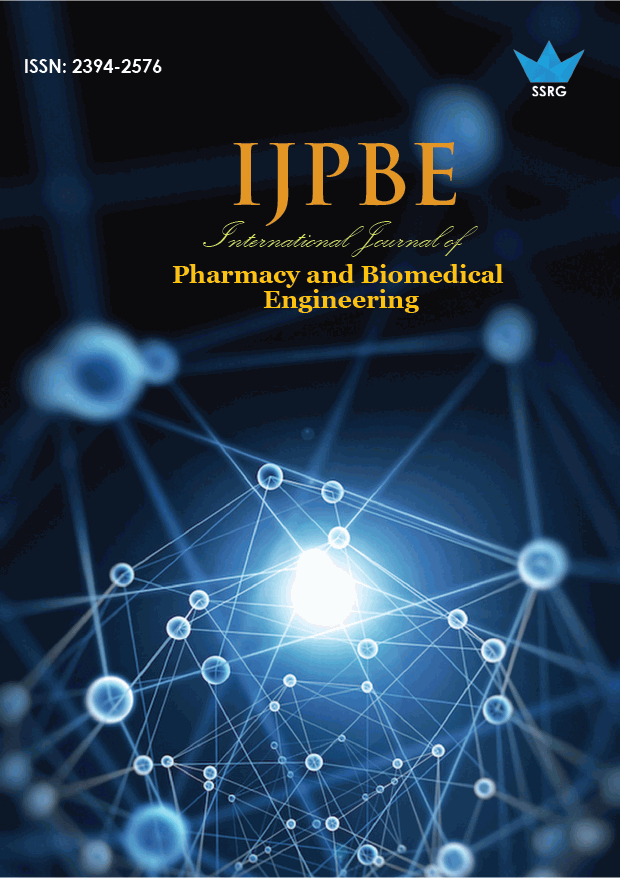Tri phasic therapy for sudden cardiac arrest

| International Journal of Pharmacy and Biomedical Engineering |
| © 2016 by SSRG - IJPBE Journal |
| Volume 3 Issue 3 |
| Year of Publication : 2016 |
| Authors : C.Kavinaya and L.Ashuthoshkumar |
How to Cite?
C.Kavinaya and L.Ashuthoshkumar, "Tri phasic therapy for sudden cardiac arrest," SSRG International Journal of Pharmacy and Biomedical Engineering, vol. 3, no. 3, pp. 1-3, 2016. Crossref, https://doi.org/10.14445/23942576/IJPBE-V3I3P101
Abstract:
Ventricular fibrillation is a disorder that presents uncooperative shriveling of the cardiac muscle of the ventricles in the mood, producing them shiver rather than indenture properly. Ventricular fibrillation is the record normally recognized in cardiac trepidation patients. Two phasic defibrillation waveforms are most popularly recognized rather than the effect of dismissing ventricular fibrillation (VF) than monophasic waveforms. The hypothesis phases improve efficiency. Two phases are improved than one, this unsurprising indication to the hypothesis. Our research leads to adding one additional phase to the patterned hypothesis. We observed the effectiveness of 19dissimilartriphasic waveforms in the chorus. We confirmed the degree of recovery, i.e., effective defibrillation, 22 guinea livestock (825-1100 g) using single phasic, two phasic, and triphasic defibrillation waveforms. We can control the single-phase and bi-phase waveforms. VF was electrically talked into twenty times per visceral, and a single defibrillation challenge was prepared using a test waveform VF episode. All waveform was used to the energy prerequisite to defibrillate that bodily 55% of the time, through a biphasic waveform as a control.
Keywords:
Ventricular fibrillation, triphasic waveforms, hypothesis.
References:
[1] J. L. Jones and R. E. Jones, "Improved safety factor for triphasic defibrillator waveforms," Circ. Res., vol. 64(6), pp. 1172-7, Jun1989.
[2] Y. Zhang, "Surgical open-chest ventricular defibrillation: triphasic waveforms are superior to biphasic waveforms," Pacing Clin.Electrophysiol., vol. 27(7), pp. 941-8, Jul 2004.
[3] R. D. White, "Waveforms for defibrillation and cardioversion: recent experimental and clinical studies," Curr. Opin. Crit. Care, vol. 10(3). pp. 202-7, Jun 2004.
[4] M. Block and G. Breithardt, "Optimizing defibrillation through improved waveforms," Pacing Clin. Electrophysiol., vol. 18(3 Pt2), pp. 526-38, March 1995.
[5] B. J. Kidwai, A. Mcintyre, J. Anderson, and A.A. Adgey, "Optimization of transthoracic ventricular defibrillationbiphasic and triphasic shocks, waveform rounding, andsynchronized shock delivery," J. Electrocardiol., vol. 35(3), pp. 235-44, July 2002.
[6] J. Huang, B. H. Kenknight, D. L. Rollins, W. M. Smith and R. E.Ideker, "Ventricular defibrillation with triphasic waveforms," Circulation, vol. 101(11), pp. 1324-8, 2000 Mar 21.
[7] R. A. Malkin and J. J. Souza, "Ideker RE The ventricular defibrillation and upper limit of vulnerability doseresponse curves," J. Cardiovasc. Electrophysiol., vol. 8(8), pp. 895-903, Aug 1997.
[8] R. A. Malkin, D. Guan, and J. Wikswo, "Experimental Evidence of improved Transthoracic Defibrillation Consistent withElectroporation," IEEE Trans. Biomed. Eng., vol. 53(10), pp. 1901-11, 2006.
[9] T. Compos, R. A. Malkin, and R. E. Ideker, "A Bayesiandown defibrillation efficacy estimator," Pacing Clin.Electrophysiol., vol. 20, pp. 1292-1300, 1997.
[10] D. Guan and R. A. Malkin, "Analysis of the Defibrillation Efficacyfor 5-ms Waveforms," J. Cardiovasc. Electrophysiol., vol. 15, pp.447-54, 2004.
[11] L. A. Geddes and W. Havel, "Evolution of the optimum bidirectional (±biphasic) wave for defibrillation," Biomed. Instrum.Tech., vol. 34, pp. 39-54, 2002.
[12] G. C. Flaker, J. C. Schuder, W. C. McDaniel, H. Stoeckle, and M.Dbeis, "Superiority of biphasic shocks in defibrillation of dogs by epicardial patches and catheter electrodes," Am. Heart J. vol.118(2), pp. 288-91, 1989.

 10.14445/23942576/IJPBE-V3I3P101
10.14445/23942576/IJPBE-V3I3P101